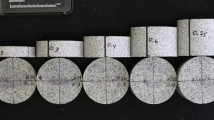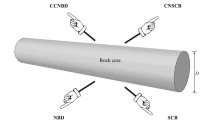Abstract
The difficulties associated with performing direct compression strength tests on rock specimens have led to development of indirect test methods for the rock strength assessment. Over the years, indirect test methods have found wide acceptance as these methods are simple, more economical, less time consuming, and easy to adapt to any field situations. Among other indirect test methods, Block Punch Index (BPI) test is a relatively new compression index test in which a small segment of core with minimal sample preparation is subjected to an increasing load until the middle part of the specimen is punched out. As per the ISRM suggested method, for the BPI test to be valid, specimen should be broken into three parts: two end parts which are fixed in the apparatus and the middle-band which is punched out. The test should be rejected as invalid if the parallel fracture planes are either absent or not fully developed or cross joints develop. The primary aim of this study is to investigate the validity of the BPI test under secondary fracture development by laboratory testing and study of stress distribution in the BPI test specimen using 3D numerical models. Observations from laboratory experiments and numerical simulation studies indicate that the development of significant tensile stresses at the bottom-middle part of the specimen caused by bending, resulting in secondary failures in the middle part of the specimen after or at the time of the shear failure along the two parallel planes. However, the study suggests that, even with the secondary (cross) fracture development, the BPI test should be considered as a valid test as along as the middle portion of the specimen is punched out along two clean parallel shear planes. Finally, based on laboratory test data on basalt and rhyolite rock types, new correlations are developed between block punch index and other material properties of rock, such as, uniaxial compression strength, splitting tensile strength, and Young’s modulus.
Similar content being viewed by others
References
Ulusay, R., Gokceoglu, C., and Sulukcu, S., Draft ISRM Suggested Method for Determining Block Punch Strength Index (BPI), Int. J. Rock Mech. Mining Sci., 2001, vol. 38, pp. 1113–1120.
Schrier, J.S., The Block Punch Index Test, Bull. Assoc. Eng. Geol., 1988, vol. 38, pp. 121–126.
Ulusay, R. and Gokceoglu, C., The Modified Block Punch Index, Canadian Geotech. J., 1997, vol. 34, pp. 991–1001.
Ulusay, R. and Gokceoglu, C., An Experiment Study on the Size Effect in Block Punch Index Test, Int. J. Rock Mech. Mining Sci., 1998, vol. 4, pp. 628–629.
Sulukcu, S. and Ulusay, R., Evaluation of the Block Punch Index Test with Particular Reference to the Size Effect Failure Mechanisms and Its Effectiveness in Prediicting Rock Strength, Int. J. Rock Mech. Min. Sci., 2001, vol. 38, pp. 1091–1111.
Karakul, H., Ulusay, R., and Isik, N.S., Empirical Models and Numerical Analysis for Assessing Strength Anisotropy based on Block Punch Index and Uniaxial Compression Strength Tests, Int. J. Rock Mech. Mining Sci.,2011, vol. 47, pp. 657–665.
Mishra, D.A. and Basu, A., Use of the Block Punch Test to Predict the Compressive and Tensile Strengths of Rocks, Int. J. Rock Mech. Mining Sci., 2012, vol. 51, pp. 119–127.
Ulusay, R. and Gokceoglu, C., A New Test Procedure for the Determination of the Block Punch Index and Its Possible Uses in Rock Engineering, ISRM News J., 1999, vol. 6, pp. 50–54.
ASTM, Standard Method for Compressive Strength and Elastic Moduli of Intact Rock Core Specimens under Varying States of Stress and Temperatures, ASTM Stand. D5873-10, 2010.
ASTM, Standard Test Method for Laboratory Determination of Water (Moisture) Content of Soil and Rock by Mass, ASTM Stand. D2216-10, 2010.
ASTM, Standard Test Method for Slake Durability of Shales and Similar Weak Rocks, ASTM Stand. D4644-08, 2008.
ASTM, Standard Test Method for Splitting Tensile Strength of Intact Rock Core Specimens, ASTM Stand. D3967-08, 2008.
Author information
Authors and Affiliations
Corresponding author
Additional information
The article is published in the original.
Rights and permissions
About this article
Cite this article
Roghanchi, P., Kallu, R.R. Block punch index (BPI) test—a new consideration on validity and correlations for basalt and rhyolite rock types. J Min Sci 50, 475–483 (2014). https://doi.org/10.1134/S1062739114030090
Received:
Published:
Issue Date:
DOI: https://doi.org/10.1134/S1062739114030090




